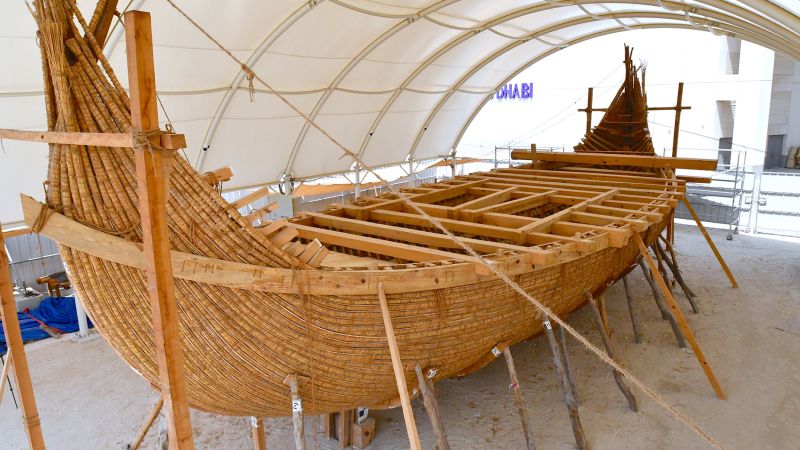Emily Harris/Zayed National Museum
A team of experts has reconstructed a Bronze Age boat using bundles of reeds and ancient techniques.
Editor’s note: This article originally appeared in CNN’s Wonder Theory science newsletter. To get it delivered to your inbox, Register for free here.
CNN
—
Tiny relics from the past offer a glimpse into a mysterious way of life.
Eyed needles made from bone, horn, and ivory It appears in the fossil record from southern Siberia about 40,000 years ago. The needle improved the efficiency of sewing, allowing for the production of warm, snug clothing in extremely cold conditions.
But researchers believe this innovation marks the beginning of a new chapter in the history of human fashion and self-expression.
Moving on to 7th century East Anglia, England, an Anglo-Saxon warrior king Buried inside a huge ship with exquisite itemsLocated at a famous spot called Sutton Hoo, the ship’s timbers have rotted away but its length can be seen from iron rivets and marks left in the soft earth.
While researchers hope to recreate the ship, it is not the only vessel to have disappeared for centuries and found new life.
Emily Harris/Zayed National Museum
The Magan set out on its maiden voyage across the Persian Gulf in March.
A team of experts from the United Arab Emirates has reconstructed a Bronze Age ship using supply lists written on clay tablets.
The shipwrights used hand tools to construct the 59-foot (18 m) long barge. Made from reeds, goat hair and animal fat.
The ship likely once carried copper, textiles and semi-precious stones between societies living in Mesopotamia and the Indus River basin.
The ship completed its maiden manned voyage in the Persian Gulf in March and will become part of a maritime history exhibit at Abu Dhabi’s Zayed National Museum.
Analysis of ancient DNA from graves in Sweden and Denmark identifies ancient strain of plague The root cause of the mysterious population decline.
Europe’s first farmers migrated from the eastern Mediterranean about 6,500 years ago, replacing hunter-gatherers and introducing a more settled agricultural lifestyle, but their populations declined dramatically between 5,300 and 4,900 years ago.
Researchers found the bacteria that causes the plague in bodies from nine cemeteries, and the carefully buried remains suggest the team may have discovered the origins of the plague.
Meanwhile, archaeologists working in Peru have unearthed what are believed to be 4,000-year-old temples and theaters, predating Machu Picchu by thousands of years. Shedding light on the region’s religious complex.
Alex Blaczkowski/Griffith University
Jacob the lion had to have his leg amputated after being caught in a poacher’s iron trap.
Jacob the African lion has overcome many obstacles to survive for 10 years in Uganda’s Queen Elizabeth National Park.
He was gored by a buffalo, caught in a poacher’s trap, and lost a leg to an iron snare. Longest recorded swim by a lion in crocodile-infested waters.
Thermal cameras captured Jacob and his brother Tib on a dangerous nighttime swim of about a mile in February.
Scientists believe the brothers were searching for a lioness after losing a fight with a male rival in the hours before their swim, and were trying to avoid human efforts to shrink lions’ natural habitat.
Boeing’s Starliner spacecraft has been docked to the International Space Station for more than a month.
Astronauts Butch Wilmore and Suni Williams stayed in the orbital laboratory for much longer than the planned eight days, “Absolutely confident” in Starliner’s ability to get them homeAccording to Wilmore.
In the meantime, the two will help with science experiments and maintenance, while NASA and Boeing engineers conduct tests to determine the cause of Starliner’s thruster problems and helium leaks.
Meanwhile, the European Space Agency unveiled its long-awaited new rocket, the Ariane 6, a satellite launch vehicle that has achieved several milestones so far. experience a flight-ending anomaly.
Love Darren/Stockholm University
Scientists have unearthed a 52,000-year-old mammoth hide from the permafrost in Siberia.
Due to the extreme cold of the Siberian permafrost, 52,000-year-old mammoth hide It is extremely well preserved and represents the first genetic repository of its kind.
The skin contains millions of letters of genetic code contained in fossil chromosomes, microscopic thread-like structures that carry DNA.
The genetic fragments, which remain largely intact from the mammoth’s living structure, could provide new insights into the extinct species.
Meanwhile, a prehistoric volcanic eruption has preserved the most complete specimen of a worm-like sea creature called a trilobite. The fossil contains never-before-seen anatomical details.
Enrich your mind with these amazing discoveries:
— Captured by the James Webb Space Telescope Shiny New Images of the Penguin and Egg GalaxyIt has been locked in a cosmic dance for millions of years.
— Astronomers have discovered glass-raining molecules on an exoplanet that have never been seen before outside our solar system. And The planet’s atmosphere smells like rotten eggs..
— The most complete dinosaur skeleton discovered in Britain in more than a century has revealed a previously unknown species of plant-eating dinosaur. They probably traveled in large groups.
— Scientists Bright Blue Tree Frog For the first time in Western Australia, you’ll experience a landscape that looks like something out of the movie Avatar.
Have you read it and liked it? Ah, but there’s more to come. Register here Get the next issue of Wonder Theory, brought to you by CNN’s space science reporter, by email Ashley Strickland and Katie HuntThey marvel at the discoveries of planets and ancient worlds outside our solar system.


